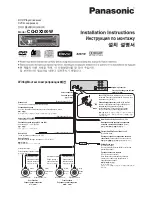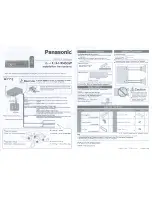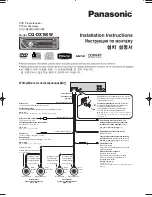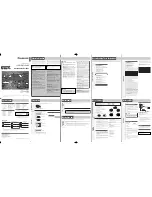
PAØPGA
5
Rotate the dial to the “0” position and check the voltage, it will be around 2.4 Volts. The manual says between 1.5 and
2.0 Volts, but none of the four receivers I tested were in that range. All of them had higher values from 2.25 – 3.1 volt
and are working fine, so I let it at that.
For alignment of the second PLL connect your dc VTVM to TP03 just in front of the MB8718 ic and rotate the dial again in
the “1000” position.
Set the bandswitch at the 5 Mhz band and adjust T2004 for a reading of 7.4 volts dc.
Change the bandswitch to the 12 Mhz band and adjust T2003 for a reading of 7.4 volts dc.
Change the bandswitch to the 20 Mhz band and adjust T2002 for a reading of 7.4 volts dc.
Change the bandswitch to the 29 Mhz band and adjust T2001 for a reading of 7.0 volts dc.
Try to make this adjustments very careful, often these voltages are too high, resulting in a loss of range or a failure to
lock properly, with a high noise level as result.
Now rotate the dial to the “0” position and change the bandswitch to 0, 6, 13 and 21 Mhz position and check the voltage
at TP03, they should be between 1.5 and 2.0 volts.
I measured voltages between 1.45 and 1.70 volts in my sets.
Be carefully with the coil cores of the PLL, they have been stabilized by a lot of wax, which can give some trouble.
Be gentle, you can “feel” trough the wax for the correct position of the core, and normally there is not much movement
necessary in any direction to obtain the correct voltage.
Don’t force things, if the core breaks, you are in trouble. In case of a broken core slot, remove the core altogether, and
put it in upside down, you have a second try this way. The cores are not interchangeable, so do one at a time.
The general alignment can be done as described in the manual, with the proper tools and equipment, it is a
straightforward job.
For a fully alignment you need a signal generator with attennuator and a range from 0.1-65 Mhz, a frequency counter,
VTVM, and if you want to align the noise blanker too, you need a noise generator.
Follow closely the procedure in the manual, if the receiver is in a normal condition, the changes should be minor.
Is the set very unsensitive, check first the semiconductors in the circuit, or there can be resistor or condensor failure, that
is much more likely than misalignment…
Closely check for abnormalities ( burnt or cracked components, bad soldering joints, bad connectors and other trouble
spots). If you check carefully, use the schematics and the very good circuit description in the handbook to make yourself
familiar with the circuits used.
My experience with 4 of this receivers is that most of the failures I encountered, where man-made by amateurs who
never read a handbook, but first plug in a soldering iron, and sell the set when the smoke has settled, and then often try
it again with the next set coming their way…..
Troubles I have encountered so far:
Power Supply:
There is a source for trouble here: the transformer, rectifier bridge and condensor 6800u/40V are always on, because they
deliver 13.5V to parts of the receiver, used for the clock and automatic switching at the selected time.
This should not put too much strain on the powersupply, because the current is minimal. The source for trouble is the
rectifier, who becomes very hot, so hot in fact that in one case the wires to the transformer caught fire, and the
condensor exploded. Check the soldering joints from the bridge, in the board, they can have some cratering, soldering
them trough with a soldering iron, is then the solution. A change for 4x 1N5405 or another bridge rectifier is also possible.
If you don’t use the receiver for automatic recording of transmissions, or for a long time, disconnect the set from the
mains, or mount a powerswitch at the backside of the set, that way there is no risk of fire. If you have the memory
option, it is best to use the backup battery adapter.
Dial Lamps:
Dial lamps are long lasting, but they have to be changed now and then. They are 12 Volt /100mA types, with long wires,
and can be obtained in every parts store. Eventually you can use bulbs with short wires and solder them to the existing
long wires after cutting away the old bulb, using isolation tube or crimping tube to isolate the wires and joints.
That way you don’t have to remove the metal frontplate for access to the soldering joints.
Содержание FRG-7700
Страница 1: ...PA PGA 1 Yaesu FRG 7700 Survival Guide...
Страница 8: ...8 PA PGA...
Страница 9: ...PA PGA 9...
Страница 10: ...10 PA PGA...

































